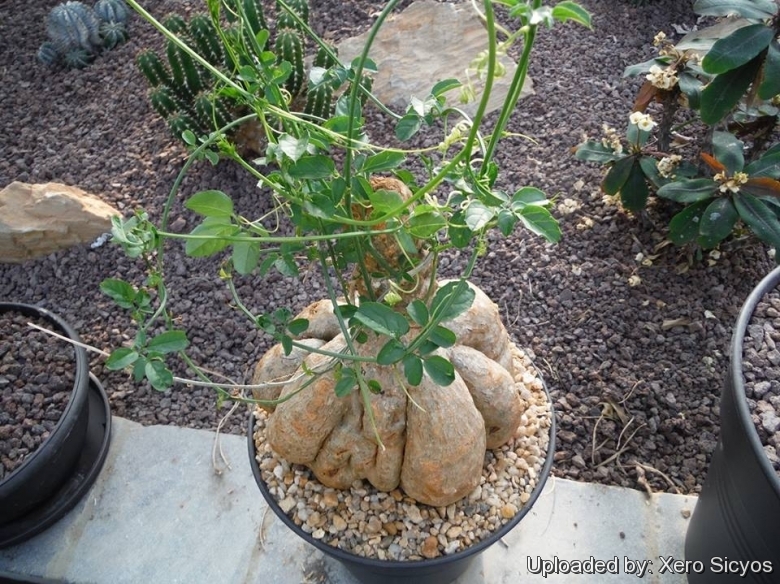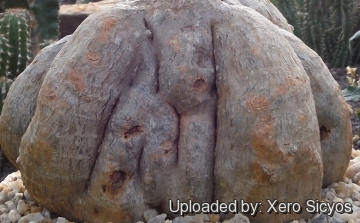




Your support is critical to our success.
- Encyclopedia of SUCCULENTS
- Encyclopedia Index
- Families
- Genera
- Species
- Cucurbitaceae
- Momordica
- Caudiciforms
Since 4 Aug 2013

Origin and Habitat: Momordica rostrataSN|34261]]SN|34261]] is common in dry areas throughout East Africa (Southern Ethiopia, Somalia, Kenya, N & Central Tanzania, NE Uganda).
Altitude range: 15–1650 m.
Habitat and ecology: The fleshy tuberous trunk of this plant is found frequently at the base of shrubs, half hidden in the undergrowth in rocky places, in dry open grassland, Acacia-Commiphora, deciduous woodland, wooded grassland and on river banks. M. rostrata is common in at least part of its distribution area, e.g. in Tanzania, and no threats are envisaged.
Synonyms:
- Momordica rostrata Zimm.
Momordica rostrata Zimm.
Cucurbitaceae
Synonymy: 2
- Momordica rostrata Zimm.
- Momordica microphylla Chiov.
HEHE (Hehe): Litambalanzoka
MAASAI or MASAI (ɔl Maa): Enkamposhi
SOMALI ( Soomaaliga): Saaro-saaro
SWAHILI ( Kiswahili): Mtunda nyoka
Description: Momordica rostrataSN|34261]]SN|34261]] is a perennial, herbaceous plant with long, slender, branches up to 7 m long, arising from a weak, irregularly-pleated, conical rootstock. Climbing vines start from the tip of caudex and climb over the surrounding vegetation, to which they cling with the aid of their simple tendrils, often suffocating them with their dense foliage. The swollen rootstock serves as a water reservoir in times of drought. Leaves with three leaflets which are further sub-divided into several other leaflets. This specie is dioecious (with separate male and female plants), but in cultivation it often appears to be monoecious. It produces a profusion of pale orange, maroon-centred flowers, female flowers are solitary, while the male flowers are clustered with 5 free petals. The fruit are bright orange-red, rostrate (beaked) hence the specific name. The flat brown-black seeds are embedded in yellow edible pulp, ripe fruit edible. The whole plant is usually glabrous.
Rootstock (caudex): Tuberous, partially exposed aboveground, dark green or brownish, tapered upwards into the stems, furrowed with vertical grooves or cleft, as hoofs, up to 60 tall and 15–20 cm across.
Stem: Up to 7 m long, green, herbaceous, basally perennial, woody, up to 7 cm in diameter and turning grey-white when older, glabrous except for hair-tufts at the nodes.
Leaves: Petiolate, alternate, pedately compound, divided into (5)9(-12) lobes arising at a common point, the lobes often being stalked, the central leaflet elliptical to almost circular 1–4.7 cm long 1–3 cm wide and the lateral lobes smaller and more rounded sometimes divided into smaller lobes 0.6–3.1 cm long. Stalk of the middle leaflet longer than the leaf stalk. Stipules absent. Petiole 2.5–25 mm long.
Tendrils: Simple.
Flowers: Dioecious (unisexual), regular, 5-merous.
Male flowers: Axillary or on contracted leafless stems, in 1-14-flowered, umbel-like inflorescences with peduncle 0.4-10 cm long. Bract 1–3 mm long subtending the flowers. Pedicels 2-13 mm long. Sepals triangular, 2-4 mm long, petals oblong, 7-13 mm long 4-8 mm wide, rounded, pale orange-yellow. Stamens 3, free.
Female flowers: Solitary, rarely paired, subsessile, sepals triangular-lanceolate, 1.5-2 mm long, Petals like those of male flowers.about 8 mm long, 4 mm wide. Ovary inferior, narrowly ovoid12–14 mm long.
Fruits (berries): Fruit on a 2–15 mm long pedicel, bright orange-red, sometimes with slight longitudinal ridges, ovoid 3-7 cm long, 1.5-3 cm in diameter, rostrate (beaked), rounded or somewhat 8-angled, with many seeds sheathed in yellow pulp.
Seeds: Broadly ovate, brownish black, about 14 mm long, 10 mm wide, 2.5 mm thick, faces sculptured.
Chromosome number: 2n. = 22
Bibliography: Major references and further lectures
1) C. Jeffrey “Flora of Tropical East Africa” 1967
2) C. Jeffrey & M. Thulin “Flora Somalia”, Vol 1, 1993 [updated by M. Thulin 2008]
3) G. J. H. Grubben “Vegetables” PROTA, 2004
4) Umberto Quattrocchi “CRC World Dictionary of Medicinal and Poisonous Plants: Common Names, Scientific Names, Eponyms, Synonyms, and Etymology” (5 Volume Set) CRC Press, 19 April 2016
5) Christopher K. Ruffo, Ann Birnie, Bo Tengnäs “Edible Wild Plants of Tanzania”
Regional Land Management Unit/Sida, 2002
6) Journal of the East Africa and Uganda Natural History Society, Volumi 15-16 East Africa and Uganda Natural History Society The Society., 1940
7) “Traditional and indigenous foods in eastern, central and southern Africa”, Volume 2 East, Central, and Southern African Health Community, 2003
8) Urs Eggli "Illustrated Handbook of Succulent Plants: Monocotyledons" Springer Science & Business Media, 06 December 2012
9) Grace Njeri Njoroge and Leonard E. Newton “Edible and Poisonous Species of Cucurbitaceae in the Central Highlands of Kenya” Journal of East African Natural History, 83(2):101-115. Nature Kenya/East African Natural History Society DOI: http://dx.doi.org/10.2982/0012-8317(1994)83[101:EAPSOC]2.0.CO;2 URL: http://www.bioone.org/doi/full/10.2982/0012-8317%281994%2983%5B101%3AEAPSOC%5D2.0.CO%3B2

Momordica rostrata Photo by: Xero Sicyos
The gallery now contains thousands of pictures, however it is possible to do even more. We are, of course, seeking photos of species not yet shown in the gallery but not only that, we are also looking for better pictures than those already present. Read More...
Cultivation and Propagation: Momordica rostrataSN|34261]]SN|34261]] grow through the summer, and die back in the fall.
Edible uses: The ripe fruits are edible, the young tender leaves are cooked alone or with other vegetables such as amaranth or peas and eaten, Coconut milk or pounded groundnuts may be added and the dish is served with stiff maize porridge or rice. The sweet juicy pulp is eaten raw, the fruits are boiled and eaten, the seeds may be roasted and eaten.
Medical uses: It is used to treat diarrhoea. A powder obtained from peeled, dried and crushed roots can kill stalkborers. The leaves are used in the treatment of malaria. The tuberous root is toxic.
Other uses: It is used as a preservative of stored grain and to kill stem borers in cereal crops. The leaves and stems serve as fodder, in Kenya especially for donkeys. The tuber was used as soap in the past.
Propagation: Seeds
| Your Actions | |
|---|---|
| Back to Momordica index | |
| Back to Cucurbitaceae index | |
 |
Back to Succulents Encyclopedia index |
Privacy stantement - Terms and conditions - How to cite - About us - Feedback - Donate




